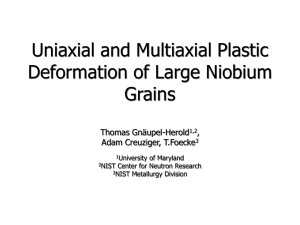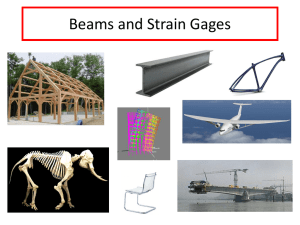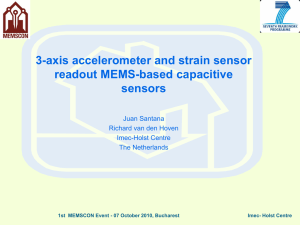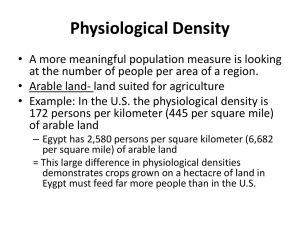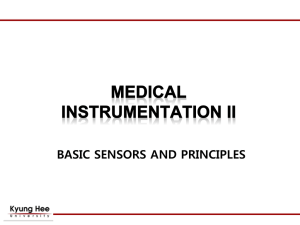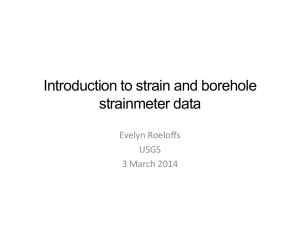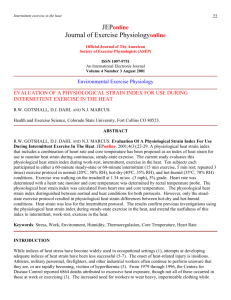Heat Stress - Issues and Questions - ThermalNet
advertisement
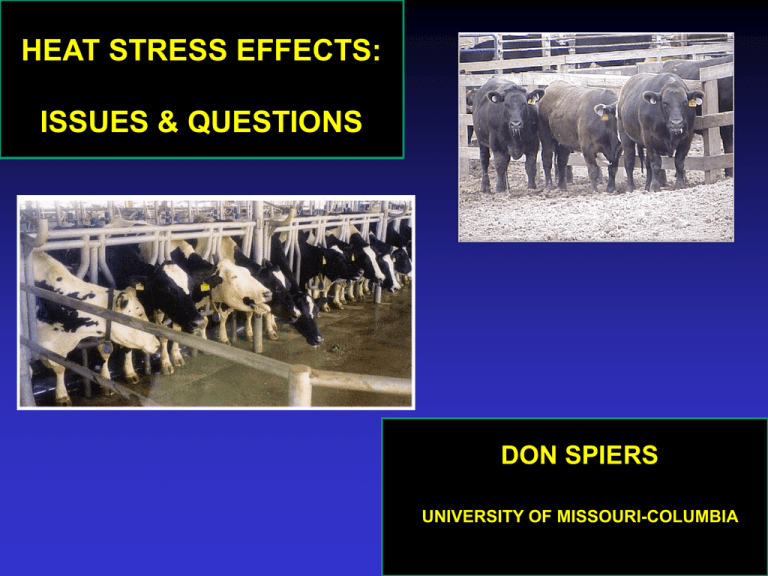
HEAT STRESS EFFECTS: ISSUES & QUESTIONS DON SPIERS UNIVERSITY OF MISSOURI-COLUMBIA WHAT IS STRESS? (Initial Question) Stress = the environment or stimulus (same for everyone) Strain = the effect or response (different for everyone) “It’s not stress that kills us, it is our reaction to it.” “I cannot, and should not, be cured of my stress but merely taught to enjoy it” Hans Selye, l950 What is heat strain? Impaired Functions (the short list) 1. Drop in production 2. Increased days open 3. Depressed immune system 4. Decreased fertility THE COST Annual losses in the US due to heat stress equal $1.7 billion. Dairy = $897 million Beef = $369 million PHYSIOLOGICAL CHANGES 1. Thermal Status 2. General Effects 3. Immune Condition 4. Nutritional Status 5. Behavior 6. Endocrine 7. Reproductive Status Heat Stress - Physiological Strain Thermal Status 1. ↑ Core Body Temperature – rumen – tympanic – intraperitoneal A. Total Body Heat Content 2. ↑ Respiration Rate and Respiratory Evaporative Heat Loss 3. ↑ Skin Temperature, Blood Flow, and Sweat Rate A. ↓ Blood Flow to Internal Organs 4. ↑ Salivation, Drooling, and Panting Rates 5. ↓ Metabolic and Heat Production Rates 6. ↓ Heat Loss via Radiant, Conductive, and Convective Avenues 7. ↑ Dehydration Heat Stress - Physiological Strain General 1. ↑ Impact Other Stressors 2. ↑ Heart and Pulse Rates 3. ↑ Hyperventilation A. B. C. D. ↓ ↓ ↓ ↑ Blood Carbon Dioxide Blood Bicarbonate Blood Buffering Capacity Respiratory Alkalosis 4. ↑ Urinary Sodium and Bicarbonate Excretion 5. ↓ Hepatic Portal Blood Flow 6. ↑ Hepatic Vitamin A Storage 7. ↑ General Vitamin E Deficiency Heat Stress - Physiological Strain Immune Status 1. ↓ Immune Function 2. ↑ Susceptibility to Parasitic and Nonparasitic Diseases 3. ↑ Mastitis 4. ↑ Somatic Cell Count 5. ↑ Plasma Antibody - Immunoglobulin Concentration 6. ↑ Death Heat Stress - Physiological Strain Nutritional Status 1. ↓ DMI, Weight Gain or Growth, Condition Score, and Blood Glucose Level 2. ↑ Energy Requirement for Maintenance 3. ↑ Salivation A. B. C. D. ↓ ↓ ↓ ↑ Saliva to Rumen Salivary Bicarbonate Pool for Rumenal Buffering Rumen pH Acidosis 4. ↑ Potassium Loss from Skin 5. ↑ Dietary Requirements for Potassium and Sodium 6. ↑ Urinary Nitrogen Loss 7. ↑ Water Intake Heat Stress - Physiological Strain Nutritional Status - continued 8. ↓ Rumination A. B. C. D. E. ↓ Gut and Rumen Motility ↓ Gut Passage Rate ↑ Gut Fill ↓ Rumen Volatile Fatty Acid Concentration ↑ Acetate to Propionate Ratio Milk Production 1. ↓ Milk Production 2. ↓ Mammary Blood Flow 3. ↓ Mammogenesis 4. ↓ Lactation Peaks 5. ↓ Milk Component Levels Heat Stress - Physiological Strain Behavior 1. ↓ Grazing Time 2. ↑ Lethargy 3. ↑ Shadow or Shade Seeking 4. ↑ Body Alignment with Solar Radiation 5. ↑ Standing Time 6. ↑ Crowding Water Trough and Splashing 7. ↑ Agitation and Restlessness Heat Stress - Physiological Strain Endocrine 1. ↓ Hormones Linked to Metabolism – Thyroxine, Somatotropin, Cortisol 2. ↑ Hormones Linked to Water and Electrolyte Metabolism – Antidiuretic Hormone, Aldosterone 3. ↑ Catecholamines – Epinephrine and Norepinephrine 4. ↑ Prolactin and ↓ Prolactin Receptor Numbers 5. ↑ Leptin 6. ↑ Insulin >> ↓ Blood Glucose Heat Stress - Physiological Strain Reproductive Status 1. ↓ Breeding Efficiency and Conception Rate 2. ↑ Fetal and Postnatal Mortalities + ↓ Calf Birth Weight 3. ↓ Semen Quality A. ↓ Spermatogenesis B. ↓ Sperm Motility C. ↑ Percent Abnormal and Aged Sperm 4. ↓ Estrous Activity A. ↓ Estrous Duration B. ↓ Heat Detection 5. ↓ Uterine Blood Flow A. ↓ Placental Weight and Growth + ↑ Retained Placenta B. ↓ Gestation Period C. ↑ Labor and Delivery Difficulties Heat Stress - Physiological Strain Reproductive Status - continued 6. ↓ Follicular Development A. B. C. 7. ↓ Oocyte quality ↑ Multiple Ovulations and Twinning ↓ Corporea Lutea Size Biochemical Changes A. B. C. D. E. ↓ Plasma LH ↑ Ketone and NEFA Levels at Calving ↓ Thyroxine During Pregnancy ↑ Plasma Progesterone During Late Gestation ↑ Prostaglandin Synthesis Rate and Level During Early Postpartum Period CAN WE REDUCE THE PROBLEM FROM THE THERMAL STATUS PERSPECTIVE? Influenced by Body Surface Area Body Coverings Water Exchange Blood Flow Environment: Temperature Wind Humidity Evaporative Cooling Non-Evap. Cooling Radiation Respiration Convection Skin Influenced by Sources Calorigenic Hormones Food Production: Milk Meat Wool Body Reserves Muscular Environment Rumen or Cecum Fermentation Activity Maintenance Conduction HEAT GAIN HEAT LOSS Hypothermia Light Bulbs Hyperthermia Normal Body Temperature BIG PROBLEM METABOLISM OR HEAT PRODUCTION 1 ADULT HUMAN = 1 - 100 WATT LIGHT BULB 1 LACTATING DAIRY COW = 16 - 100 WATT LIGHT BULBS BIG BOVINE PROBLEM = HUGE HEAT PRODUCTION Occurs with reduction in feed intake. AVENUES OF HEAT LOSS CONDUCTION Conductive, Convective, and Radiative Exchanges Require a Temperature Gradient CONDUCTION RADIATION CONVECTION LESS EFFECTIVE AS AIR TEMPERATURE APPROACHES SKIN TEMPERATURE EVAPORATIVE EXCHANGE Only Solution is Increase Evaporative Heat Loss Non-Evaporative Process 2 Heat Dissipation (kcal/m/hr) Surface Vaporization 140 120 Respiratory Vaporization 100 80 60 40 20 0 0 20 40 60 80 100 Ambient Temperature ( oF) Redrawn from Yeck and Kibler (1956) and Kibler and Yeck (1959) BUT A CHALLENGE TO CHANGE ESPECIALLY FOR BEEF CATTLE AND GRAZING DAIRY COWS MANY DIFFERENT LEVELS OF SENSITIVITY COMPLICATING FACTORS: 1. Breed 2. Age 3. Health 4. Gender 5. Geographic Location and Climate 6. Acclimation Duration IS IT POSSIBLE TO PREDICT ANIMAL RESPONSE TO HEAT STRESS? 1. Remove or provide extra care for “sensitive” animals A. Change environment B. Change animal 1. Reduce heat production 2. Increase heat loss 2. Identify heat extremes in advance A. Change environment B. Change animal 1. Reduce heat production 2. Increase heat loss 3. Acclimation Program Present AMBIENT CONDITION ANIMAL PRODUCTIVITY ANIMAL THERMAL STATUS AMBIENT CONDITION Extremely difficult Present Why? ANIMAL PRODUCTIVITY Ambient condition = indirect stressor Does not account for “Complicating Factors” Temperature Humidity Index is an example AMBIENT CONDITION Improvement Why? Account s for “Complicating Factors” Physiological Strain Index is an example ANIMAL THERMAL STATUS Present AMBIENT CONDITION ANIMAL PRODUCTIVITY ANIMAL THERMAL STATUS Performance or Health Critical Zone ? HYPERTHERMIA WEIGHT LOSS DYSFUNCTION DISEASE DEATH Stress or Strain Young’s Modulus of Elasticity = object or substance's tendency to be deformed elastically (i.e., non-permanently) when a force is applied to it. The elastic modulus of an object is defined as the slope of its stress-strain curve in the elastic deformation region: Elasticity = Stress/Strain Thomas Young “If it were possible to measure quantitatively all the strains responding to a given stress, we could devise a type of Young’s Modulus of Elasticity (stress/strain). The reciprocal of this (strain/stress) would represent the additive compliance of animals and might be called an index of adaptation. This index could be of value both in determining the degree of adaptation achieved by an animal after a given period of exposure to the stress and in determining when adaptation is complete. It might also be useful in comparing the degree of adaptation achieved by different species under similar conditions.“ Melvin Fregly Symposium Conducted by The National Academy of Sciences-National Research Council August, 1966 Being healthy means being able to adapt to and overcome obstacles. It allows"a margin of tolerance for the inconsistencies of the environment." Health is a "regulatory flywheel of the possibilities of reaction" . Normative beings are able to deal with conflicts in a way that leaves open the possibility of future correction. Any normality limited to maintaining itself, hostile to any variation in the themes that express it, and incapable of adapting to new situations does not represent health. An organism is healthy to the extent that it is capable of adjusting these norms in the face of changing circumstances. Georges Canguilhem



